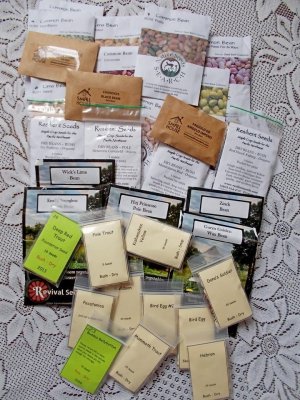flowerbug
Garden Master
"Frenching" with green beans means cutting off the tips.
never heard that term applied in that context before. haha. interesting...
"Frenching" with green beans means cutting off the tips.
Are dried beans more likely to be purchased in a store, or are they just not really part of the food culture? Admittedly, though Canada is a large international legume exporter, the average diet here doesn't contain them in any significant way. Baked beans with pork and molasses is the only official recipe I can think of.
Growing good quality dry beans in our still fairly moist climate in the U.S. is still a challenge. It takes some learning of technique of what to do and when to do it.my own experience with growing beans in a somewhat non-optimal area has shown that it is possible but not always easy.
White beans are very mild in flavor and goes easily with anything a food company wants to pair them up with. Changing people's eating habits to more plant based or bean based diet is not easy. It's almost as if they have to get the idea of it themselves.the Heinz bean plant is huge. there's some videos of them making beans and of course a large percentage of those beans come from North American growers. they only want the white Navy Pea Beans which are acceptable as so many do eat them, but how do we get people to try other beans and other ways of eating them? one bean eater at a time...
Yes! That brings back memories, although I've never seen them canned (never looked) but used to purchase frozen "French-cut green beans" with slivered almonds. Basically just julienned green beans, but the long slender ones that you've mentioned. I even bought one of those gizmos from Lehman's back in the day and had forgotten that I have it!I also vaguely remember it being a style of store-bought, metal-canned bean where the beans were 'frenched'. I assume that's related to this sort of gizmo which I've seen, and may have had as a kid, but don't remember ever using.
 So thank you for that reminder. Could have put that to good use this summer, dang it.
So thank you for that reminder. Could have put that to good use this summer, dang it. I suspect this is why favas are so much more popular on that side of the puddle.i think these things are factors, but if the UK is generally cooler and damp then a dry bean harvest is not easy to accomplish without some dedication (aka labor). fresh green or wax beans are a different story entirely.
my own experience with growing beans in a somewhat non-optimal area has shown that it is possible but not always easy.
Your 'hanging them in the sun' technique was exceptionally helpful over here! Removing the leaves made a big difference too (although I'm reserving that for when I think it is necessary).Growing good quality dry beans in our still fairly moist climate in the U.S. is still a challenge. It takes some learning of technique of what to do and when to do it.

That said, it is easy to harvest a dry crop of favas in the British climate, but they're almost exclusively eaten green.I suspect this is why favas are so much more popular on that side of the puddle.